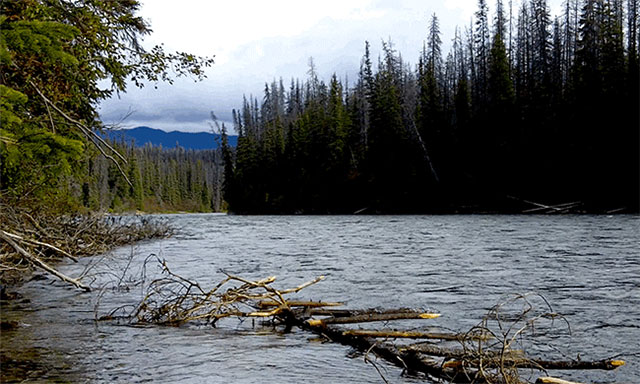
Down a logging road in northern British Columbia, signs of modern life slowly disappear. Blue, snow-capped mountains fill the landscape, their yellowed forests bearing the scars of clear-cutting and the ravenous pine beetle, while the road begins to mimic the path of a river.
Forty miles into the wilderness, visitors reach a bridge checkpoint: an entrance into Unist’ot’en territory. A young man in thick winter gear walks across a bridge to meet them. He asks for names. The volunteer communicates by radio to the clan’s spokesperson, who arrives shortly and takes visitors through a protocol used by generations of indigenous peoples to determine entry onto their lands.
There is a series of questions:
“What’s your name?”
“Do you work for industry or government that’s destroying our land?”
“What skills do you bring here?”
“How long do you plan to stay?”
“How will your visit benefit the Unist’ot’en?”
Freda Huson then steps away and softly radios across the camp. Volunteers emerge to remove the heavy wooden barricades at both ends of the bridge and allow passage onto the Unist’ot’en land.
This clan of the Wet’suwet’en First Nation has occupied its traditional territory here for more than five years, a response to a proposed network of pipelines full of crude oil and fracked natural gas that would cross this landscape from the energy nexus in Alberta to the West Coast. Plans for Chevron’s nearly 300-mile Pacific Trail natural gas pipeline, the double-barreled, about 725-mile Northern Gateway crude oil pipeline, and TransCanada’s more than 400-mile Coastal GasLink natural gas pipeline, extending across western Canada and destined for Asian markets, have created deep tension between industry and resistant First Nations clans like the Unist’ot’en.
Despite a series of cases in the Canadian courts upholding the sovereignty of unceded indigenous lands, the Unist’ot’en have turned away a steady flow of police and industry officials at the clan’s bridge checkpoint and confronted others entering remote areas of the territory by helicopter.
Threats from the energy industry and the Royal Canadian Mounted Police rest on an ambiguous interpretation of Aboriginal law. But defenders at the Unist’ot’en Camp see no such ambiguity. Within the traditional laws passed down through their elders, defense of the land is an imperative.
Huson, chosen as spokesperson by the chiefs of her clan, leads the struggle at the frontlines. She makes no decisions without the consent of her chiefs, driven by an ultimate truth: Her ancestors are still present on that land, still guiding her and her people and allowing her to reconnect with the land and reinforce a relationship that sustained indigenous populations for thousands of years.
“I went to the tar sands and saw the devastation and destruction,” Huson says. “Just listening to the ladies that are from that Nation, crying and telling their story, how they can’t even eat the fish anymore and they can’t even eat the moose anymore. Their total lifestyle is destroyed. I don’t want to wait until we lose everything before I do something. It’s high time that we start doing something; otherwise we’ll be telling those same stories.”
The Unist’ot’en’s effort is twofold: While it occupies the land along with a rotating set of volunteers from all over the world to stop pipelines, it also cultivates a stewardship for land stripped steadily from indigenous populations as Western expansion made their territories smaller and their land infertile.
“These lands belong to us,” says Toghestiy, a hereditary chief of the Likhts’amisyu clan of the Wet’suwet’en First Nation and a supporter of the camp from the beginning. “They’ve never been ceded or surrendered to anybody. This place is not Canada. It’s not BC It in particular is Unist’ot’en territory, and it is occupied and protected.”
On a brisk September day on the Unist’ot’en side of the bridge, volunteers spread across the camp to complete the day’s tasks, outlined on two adjacent dry-erase boards in the Healing Centre. Some staff the checkpoint; others travel deep into the territory to keep watch at satellite camps used to monitor helicopter activity and attempts to enter the land. Still others feed the animals and cook meals. The roar of chainsaws can be heard in the distance, turning to firewood the felled trees killed off by the pine beetle. Volunteers from other Nations along with non-indigenous volunteers level the soil around the Healing Centre, working not in defense of their own sacred land and culture but as an act of solidarity.
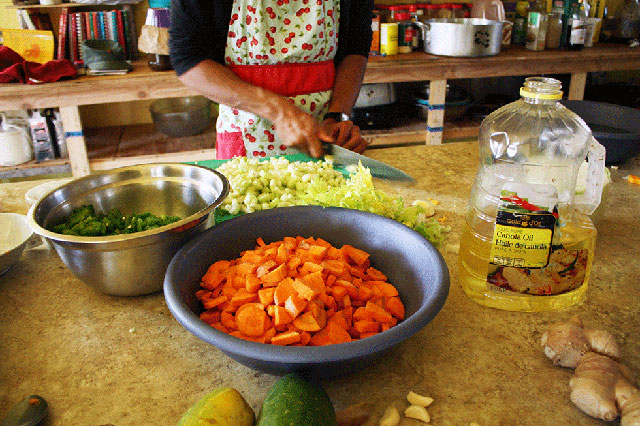 Volunteers use food from the garden to prepare meals for everyone. Nothing is wasted. (Photo: Stephen Miller)
Volunteers use food from the garden to prepare meals for everyone. Nothing is wasted. (Photo: Stephen Miller)
Despite spending most of their lives outside their traditional territories, the Wet’suwet’en in particular have maintained a close cultural connection to the land. In the absence of a treaty, the territory was never taken from its traditional keepers, as has been the case for so many other First Nations.
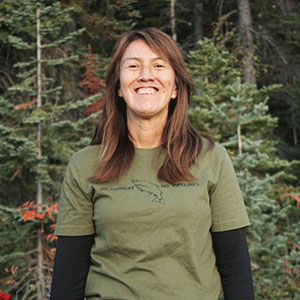 Freda Huson, spokesperson for the Unist’ot’en clan. (Photo: Stephen Miller)Huson says years of foresight allowed the clan to prepare for the pipelines. Her fears reached a threshold following the deaths of her brother several years ago and her father soon afterward. During funeral services for her brother, Huson says, Pacific Trail brought in drill equipment to the unguarded territory. After her father died last year, she says Coastal GasLink entered the territory by helicopter for an environmental assessment. “The helicopter landed on the road the very day I was burying my dad.” Realizing that they could not protect the territory while on the reservation two hours away, the clan decided to occupy.
Freda Huson, spokesperson for the Unist’ot’en clan. (Photo: Stephen Miller)Huson says years of foresight allowed the clan to prepare for the pipelines. Her fears reached a threshold following the deaths of her brother several years ago and her father soon afterward. During funeral services for her brother, Huson says, Pacific Trail brought in drill equipment to the unguarded territory. After her father died last year, she says Coastal GasLink entered the territory by helicopter for an environmental assessment. “The helicopter landed on the road the very day I was burying my dad.” Realizing that they could not protect the territory while on the reservation two hours away, the clan decided to occupy.
Huson walks the narrow paths of the permaculture garden, a small, expanding field of cabbage, kale, and root vegetables that is becoming a sustainable food source for the camp and stands directly in the path of the proposed Coastal GasLink Pipeline. Ultimately, the vision for this camp is not only to sustain the clan and to inspire grassroots movements, it is to preserve natural resources for everyone. “We always have to be mindful that we are the first people of the headwaters,” Huson says. “This water hits us first; it’s our duty that we’re not making decisions that are going to impact clans downstream from us.”
Movements like the Unist’ot’en’s are seeing results. The clan is building a grassroots network with dozens of other First Nations protesting the coal mining, tar sands extraction, oil drilling, and natural gas exploration that have become the main driver of the Canadian economy. On Lelu Island, similarly unceded land off Canada’s Pacific Coast, the Lax Kw’alaams Nation turned down a $1 billion offer and for months has held off the construction of a liquefied natural gas terminal that would threaten local salmon runs. Other clans of the Wet’suwet’en Nation, as well as the Gitxsan and St’at’imc Nations, have established occupations this year.
But despite Prime Minister Stephen Harper’s ousting in October, which may mark the end of a nearly decade-long era of oil and gas expansion in Canada, supporters of the camp have little faith that the solution to their struggles lies within the electoral system.
While power has shifted in the Canadian government, some in the industry have updated their strategies, as well. After engaging with First Nations and citing the potential impact of pipelines on water flows into the Wedzin Kwah (the First Nation name for the Morice River), TransCanada recently announced a rerouting of its Coastal GasLink proposal, moving 34 miles of the path 3 miles north – avoiding the permanent structures erected by the Unist’ot’en along the Wedzin Kwah, but still cutting through the clan’s territory. Chevron has remained intent on its route for the Pacific Trail Pipeline.
As for the Northern Gateway, newly elected Prime Minister Justin Trudeau may have killed the pipeline with a recent decision to ban oil tankers on British Columbia’s north coast, although the company remains committed to its construction. The Unist’ot’en are quick to celebrate incremental victories. Shell’s recent suspension of its Arctic drilling operation and President Obama’s rejection of the Keystone XL pipeline mark not only success for their allies, but for the Earth itself.
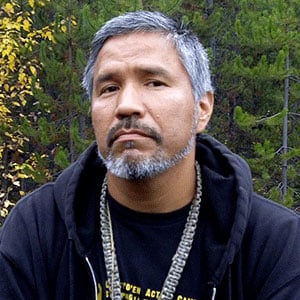 Mel Bazil, Gitxsan and Wet’suwet’en Nation, central British Columbia. (Photo: Stephen Miller)But Mel Bazil, a man of Gitxsan and Wet’suwet’en heritage and a longtime supporter of the Unist’ot’en, believes the situation remains urgent: Indigenous peoples have already begun to face the harsh realities of climate change around the world. “[The land] needs healing,” says Bazil. “We can’t depend on it in completion right now – there’s so much of it that’s in pain. Part of that healing is leaving it alone, allowing it to regenerate – the Earth can take care of herself. But we have to step in front of new companies looking to destroy it further.”
Mel Bazil, Gitxsan and Wet’suwet’en Nation, central British Columbia. (Photo: Stephen Miller)But Mel Bazil, a man of Gitxsan and Wet’suwet’en heritage and a longtime supporter of the Unist’ot’en, believes the situation remains urgent: Indigenous peoples have already begun to face the harsh realities of climate change around the world. “[The land] needs healing,” says Bazil. “We can’t depend on it in completion right now – there’s so much of it that’s in pain. Part of that healing is leaving it alone, allowing it to regenerate – the Earth can take care of herself. But we have to step in front of new companies looking to destroy it further.”
Despite resistance from hereditary leaders, industry officials say they established their projects with significant First Nations support. Chevron officials say all 16 governmental bands along the proposed path have joined its First Nations Limited Partnership and that the project will bring economic benefits to those communities – $137.4 million in contracts awarded to First Nations businesses, or 85 percent of the contracts. TransCanada claims its project would have similar benefits, saying its updated route is a direct result of consultation with Aboriginal groups.
But Huson is not looking for short-term benefits. She believes the elected chief system has been co-opted by the Canadian government, often working against their traditional law for the negligible short-term benefit of the clans on reserve.
The Unist’ot’en’s fight is for more than preserving land; the clan is taking a stand for traditional ways and against an industry that has contributed so much to climate change.
It is early evening at the camp. A young man from the Sucker Creek Cree First Nation named Nipawi Mahihkan Misit Kakinoosit (“Standing Wolf Paw”) bellows for the volunteers to gather for the predinner prayer circle. His voice reaches everyone easily with little more to cut through than the drizzle of a sunshower and the wind through the trees. A small group of volunteers walks out to join from the kitchen, where they have been playing music and working to prepare dinner: salmon pasta, fried bear fat, deer tripe, celery, and roasted carrots.
Nothing goes to waste. Julia Michaelis, a longtime volunteer at the camp, says the meals maintain morale, marking the one time each day the entire group can talk and enjoy each others’ company. “There’s a lot of hard work,” she says. “There’s a lot of physical labor. People are cold. People are missing their families. We worry about what’s going to happen with the confrontation. And so it’s this one time where everybody sits down together for half an hour or an hour and enjoys something together.”
Many indigenous volunteers commit to the frontlines like this. Other volunteers have come from around the world, many who have spent their lives embedded in the same fevered Western culture the clan defends itself against. Huson attributes virtually all of the camp’s volunteer support to the work of activist Zoe Blunt, who in 2012 bought a 48-passenger bus, filled it with volunteers and supplies, and traveled to the Unist’ot’en Camp. The annual Unist’ot’en Action Camp includes a week of building structures, workshops on decolonization, and a bridging of the divide between indigenous and non-indigenous cultures.
For those who come from privileged backgrounds, the camp strips away those attitudes – a prerequisite for any successful act of solidarity.
“We live in the truth,” says Toghestiy. “It encourages people to walk away from a mindset that they may have been raised in, that they may be working for, that they may be empowering. It forces them to question that, and once they begin to question that, they start to re-establish a set of moral values within themselves that will change them and begin changing people around them.”
In nearby Houston, BC, workers in reflective uniforms compare the lengths of their truck beds over breakfast at a local diner. The town’s major industries – logging, mining, and tourism based heavily on steelhead fishing – represented the most acute threat to the unceded Unist’ot’en territory prior to the recent threat of pipelines.
While many of the Unist’ot’en’s greatest obstacles are products of a parochial Western economic system that relies heavily on the type of work done by the clan’s closest Canadian neighbors, camp leaders are forgiving of individuals within the mainstream culture. Those who work with energy companies, as well as those representing their reservations in governmental bands, often make decisions driven by financial need. But Huson is quick to point out that any personal ill will toward them is misguided.
For First Nations, pipeline deals often mean immediate relief for their communities, where unemployment is widespread and more than 25 percent of children live below the poverty line. For Canadians working in the oil industry it’s much the same – earning a living through the mainstream economy is the only option available to provide for their families.
“People make decisions depending on where they’re at and depending on the information they have,” Huson says. “If they don’t have all the information, they’re going to make bad decisions. It’s not their character making them, so you don’t need to bash their character. You just have to question them. ‘How did you arrive at the decision? Do you know all the information? Do you know all of the facts?’ I just tell people, ‘Educate yourselves.'”
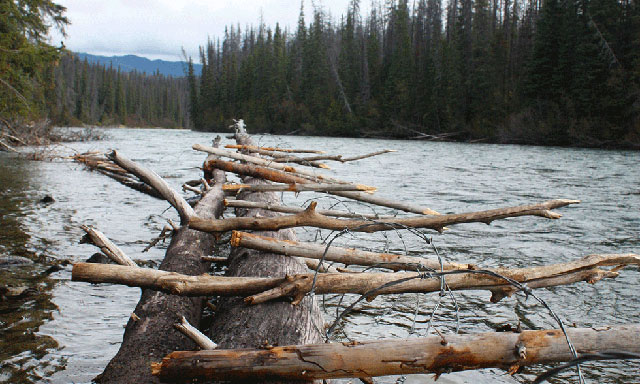 Barbed wire along the Wedzin Kwah prevents boats from entering the Unist’ot’en territory. (Photo: Stephen Miller)
Barbed wire along the Wedzin Kwah prevents boats from entering the Unist’ot’en territory. (Photo: Stephen Miller)
As word of the Unist’ot’en occupation has spread, education has become a cornerstone of the camp’s mission. And the cultural drive behind their stand, supporter Mel Bazil says, has created a shockwave among those waking up to the realities of climate change. “It’s a reciprocal culture; it never really ended,” he says. “To share that knowledge outwardly to other grassroots folks – migrants and grassroots settlers, as well as other indigenous nations – it’s been very, very powerful to see our people come together. Not just in the face of devastation and destruction, but to survive and to understand each other.”
Few places on Earth remain as pristine as the Unist’ot’en ancestral lands. Deer, grouse, and the occasional moose or black bear are still hunted and trapped. Berries are gathered. Plants used for medicines still blanket the land. Salmon still make their seasonal runs past the territory with a regularity no longer seen in areas where waterways have been polluted or disturbed. The water from the fast-flowing Wedzin Kwah, which the clan calls its lifeblood, can be drunk straight from the river. In the words of one volunteer, the sound of the river “is very calming and very beautiful. It’s like a thousand whispers. You can just feel so much power, but it’s also very, very gentle.”
First Nations whose territories lie in other Canadian provinces find their ancestral lands restricted by treaties and offering them fewer opportunities to instruct their children on the cultural practices of hunting, trapping, fishing, or gathering berries and medicines outside their impoverished, government-sanctioned reserves. Chief Toghestiy remembers learning traditional ways of survival as a boy. His grandparents took him out onto his clan’s territory and taught him how to hunt, fish, and trap. He would often return with enough trout to feed his entire family. They journeyed to the outer reaches of the mountains and pointed out the boundary lines; his grandparents explained it would someday be his responsibility to protect everything within those boundaries.
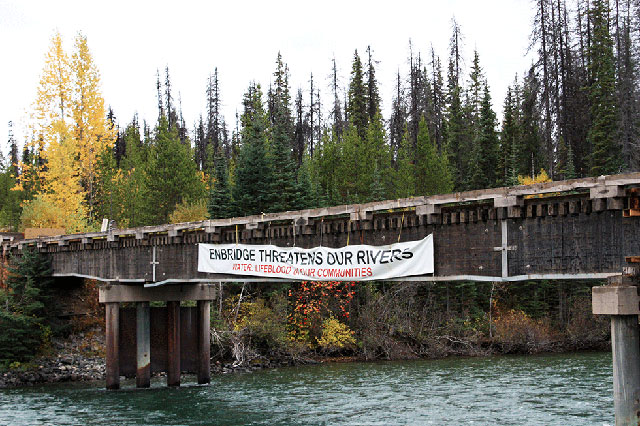 Visitors are stopped at this bridge over the Wedzin Kwah (Morice River) before entering the Unist’ot’en territory. (Photo: Stephen Miller)
Visitors are stopped at this bridge over the Wedzin Kwah (Morice River) before entering the Unist’ot’en territory. (Photo: Stephen Miller)
For those who may have skipped a generation in learning this responsibility, the Unist’ot’en’s stand acts as a lesson. “There’s a lot of people that come out here with children, and they’re fearless,” Toghestiy says. “They want their children to see: This is people occupying their lands. This is people protecting their territory.”
Living by traditional methods was largely absent for the parents and grandparents of today’s First Nations youth. Niiga Payon Nooke Bineeshe Wook, an Aamjiwnaang man, grapples with whether he will even register his young child with a Canadian birth certificate or within his own Nation’s system. He comes to the Unist’ot’en camp from southwestern Ontario’s Chemical Valley, an area filled with more than 60 chemical plants that have engulfed several First Nations territories. The international border drawn along the St. Clair River is all that divides his land from several more in neighboring Michigan. The First Nations in this area, the most highly polluted in Canada, have endured a string of bizarre health consequences, from a ratio of two females born for every one male to staggering rates of lung cancer and miscarriages.
While at the Unist’ot’en camp, he experienced his first successful grouse hunt – a skill he had put off learning but one that ultimately will aid him in supporting his family. Toghestiy, passing along the lessons of his grandparents, accompanied him.
The Unist’ot’en, like most clans, sustained themselves with traditional practices for thousands of years. They now live by two very simple assertions: The responsibility of traditional law to coexist with the Earth supersedes any rights that a government could give the clan, and the wealth offered by the Earth outweighs any number of dollars offered by industry.
“I think [the camp is] still standing because the clan stepped off of all boardroom tables,” Bazil says. “They operate from the land, where assertion belongs. They’re asserting their responsibilities; they’re not fighting for their rights.”
The first snows of the winter have fallen at the Unist’ot’en camp, and the community is well-equipped to weather a long season. The newly insulated Healing Centre provides one more protective structure than was standing a year before. Jars of salmon and preserves line the perimeter of its second floor, stacked waist-high, collected and stored throughout the warm months of abundance.
While the threat of pipelines looms, the camp continues to work on its permanent structures with a confidence that this way of life will stay protected.
When time and the deep snows permit Huson to step away for a moment, she will make her way around Canada to give talks not only in an effort to share the clan’s struggle, but also to empower other land defenders. Chief Toghestiy will return to his territory to build a cabin for his own clan’s occupation; Bazil will meet with comrades across the region. Volunteers will return home to Vancouver or Seattle, Alberta or Ontario. When the warm months come again, more volunteers will arrive.
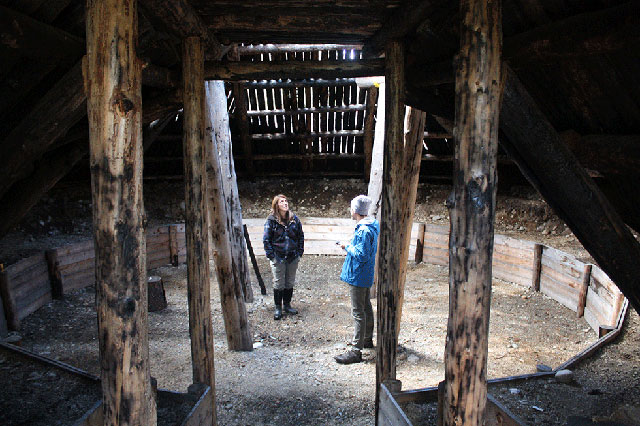 Freda Huson stands with reporter Tony Manno in the unfinished pit house, a traditional structure that will one day become her home. (Photo: Stephen Miller)
Freda Huson stands with reporter Tony Manno in the unfinished pit house, a traditional structure that will one day become her home. (Photo: Stephen Miller)
But before Huson leaves, there is still work to do. She stands under shadows of cedar bark at the center of the unfinished pit house, a traditional Native structure that will one day be covered in earth and serve as her home. The cabin she currently occupies will become a home for the elders, and the Healing Centre will welcome indigenous people from across the continent as a place to come to terms with their struggles and stand in community with others. “I see our vision happening,” Huson says. “We envisioned going back to our territory. We envisioned going back to the land. We envisioned making a prototype so the rest of the Wet’suwet’en can do the same.
“We want to show that this is doable. Move back to your land. Get off the reservations. We don’t need government to live. Just live like this.”
Press freedom is under attack
As Trump cracks down on political speech, independent media is increasingly necessary.
Truthout produces reporting you won’t see in the mainstream: journalism from the frontlines of global conflict, interviews with grassroots movement leaders, high-quality legal analysis and more.
Our work is possible thanks to reader support. Help Truthout catalyze change and social justice — make a tax-deductible monthly or one-time donation today.